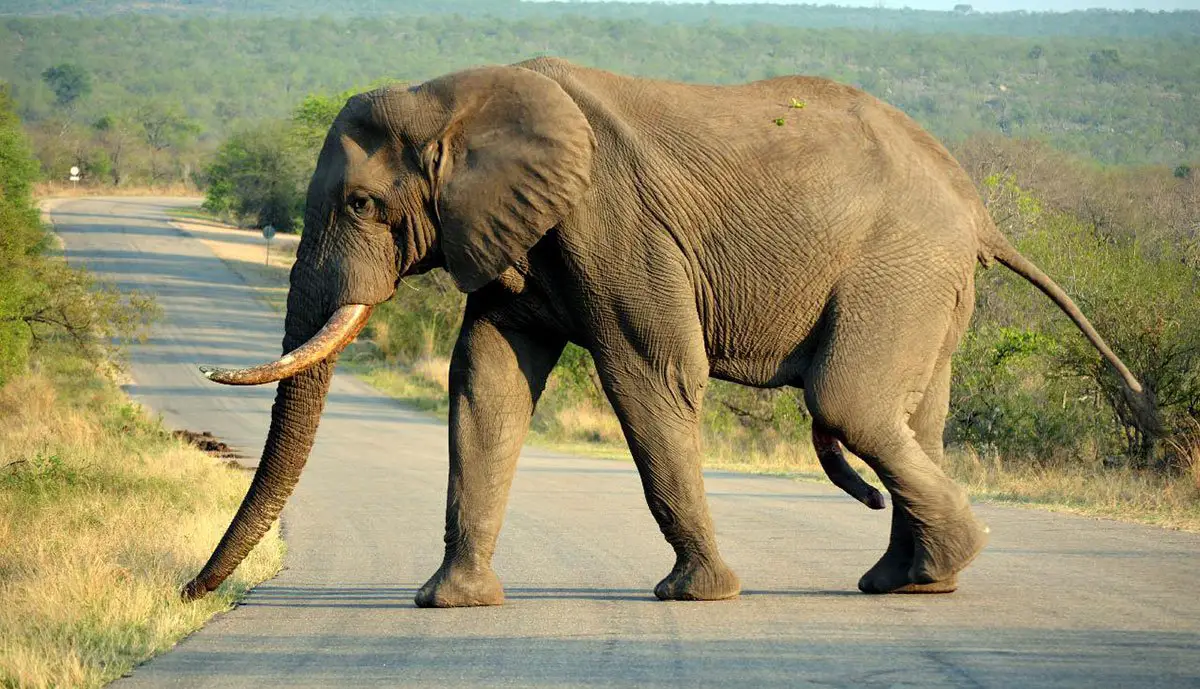In this post, we’ll learn some of the amazing chimpanzee facts for kids including its physical description, size, lifespan, habitat, diet, behavior and much more. Among primates, chimpanzees (Pan troglodytes) are by far the smartest great apes. Besides, they also have the largest brain in primates.
Chimps can easily climb up the trees thanks to their strong arms. Chimps walk on all fours, which is known as knuckle-walking. However, chimps can walk on two legs. They can walk much easily as compare to orangutans. Bonobos walk on two legs quite frequently than common chimpanzee. Chimps have powerful muscles, almost twice as much as humans.
Normally, chimps are highly territorial and aggressive animals. For that reason, they do not quite often tolerate other chimps within their social groups. With the help of tree branches, chimpanzees are quite expert in moving from one tree to another. Chimps largely eat on treetops. They are one of the very few animals that can use tools. Chimpanzees are part of the great apes family called Hominidae. What’s more, humans and gorillas also belong to the same family. Now let’s us learn all about chimpanzees and explore the chimpanzee life in detail along with chimpanzee interesting facts!
Chimpanzee🦍Facts for Kids
Species Of Chimpanzee
- Chimpanzee is a common name for two different species i.e. bonobo and common chimpanzee.
- There are four subspecies of common chimpanzee.
- Chimpanzees belong to the genus Pan.
- Until 1928, both species of chimpanzee were considered the same.
- Bonobos are peaceful animals while common chimpanzees are bigger and more aggressive.
What Do Chimpanzees Look Like?
- Chimps have black or dark brown hair.
- Unlike baboons and monkeys, chimpanzees have no tail. Orangutans and gorillas are some other apes that do not have a tail.
- There is no hair on the chimp’s soles and palm of its hands.
- As compare to its legs, the arms of a chimpanzee are longer in size.
- The arms of a chimp are about 1.5 times the size of its body.
- Bonobo’s limbs are comparatively longer than common chimps
- The color of the hairless skin of chimps ranges from pink to dark.
- A baby chimp has pink skin but it turns dark with time.

Chimpanzee – Photo © Chi King
How Big Do Chimpanzees Get?
Normally, the chimpanzee size varies from 4 to 5.5 feet in height.
How Much Does A Chimpanzee Weigh?
- A female chimp weighs around 59 to 110 pounds.
- A male adult chimpanzee can weigh from 88 to 132 pounds.
How Strong Is A Chimpanzee?
- As far as chimpanzee strength is concerned, it is about 4 to 7 times stronger as compared to humans.
- Actually, the chimpanzee muscle contains linear fibers, which makes the chimp’s muscles almost as strong as our bones.
How Long Do Chimpanzees Live?
- In the wild, the chimpanzee lifespan is about 30 years or more.
- However, the chimps tend to live longer during captivity. Some of the captive chimps have lived for as long as 75 years.
- Little Mama was one of the oldest chimpanzees. She died at an age of around 75 to 80 years at Lion Country Safari, Florida.
How Do Chimpanzees Communicate?
- The chimpanzee communication is not quite simple to understand rather it is fairly complex.
- Chimps tend to communicate with each other using hand-clapping, facial expressions and grooming.
- If other chimps are far away, the chimp may call out loudly. These calls are known as pant-hoots.
- The chimp may also call others by drumming the trees.
- When chimps are panting, they are actually greeting each other.
- If a chimp grunts and screams, it means he is irritated and angry.
How Do Chimpanzees Sleep?
- The chimpanzee sleeping habits are quite different from other primates.
- Like other primates, chimpanzees also sleep on tree branches.
- However, in order to have a good night sleep, chimps tend to build comfortable mattress-like beds, called nests.
- They make nests out of tree branches, twigs and leaves.
- In order to make their beds stronger, chimps weave together twigs and leaves from tree branches.
- Chimps tend to sleep in the same nest only for once. Thus, they have to build a new nest every night.
- Primates do not normally build nests rather they sleep on branches of tree.
- The nest of a chimpanzee is at least 16 feet in diameter and may be within a range of 10 to 150 feet high.
- In Uganda, chimps mostly prefer building nests on trees of Ugandan ironwood. These trees can be around 120 to 150 feet high.
- The ironwood is perhaps the best bed-building tree because its wood is hard enough to provide durable nest.
- One of the reasons why chimps sleep on tree canopies is that they seek to avoid predators like lions or leopards that may be active at night.
- Scientists believe that in ancient times, the common ancestors of great apes used to sleep on tree branches. However, about 14 to 18 million years ago, they started building sleeping platforms like nests. This practice continues until today.
Can Chimpanzees Swim?
- You wouldn’t really find chimpanzee swimming at all. Well, that’s because chimps don’t like swimming. There are two reasons why chimps are poor swimmers.
- First, they have low fat on their body and so, they may not be able to float well.
- Secondly, the upper part of their body is fairly heavy which means chimps are unable to keep their heads out of water.
- However, chimps may sometimes dabble their feet in shallow water.
Do Chimpanzees Live In Groups?
- Chimpanzees usually live in large social groups. Therefore, it is very important to know chimpanzee social behavior.
- Normally, the chimps live in different family groups and these groups make up one large chimp community.
- Each chimp community contains different family groups and there can be up to 100 to 150 members in this community.
- There may be around 6 to 10 animals within one family group.
- They communicate with each other by clapping their hands, facial expressions and kissing.
- Within a chimp society, the male chimp who dominates others in a social group and holds highest rank, is known as alpha.
- In the chimpanzee social structure, an alpha male is responsible for maintaining order within a group though he may not be the strongest of all.
- With the aim to threaten others and maintain highest rank, the alpha chimp will puff his chest out and would like to appear much stronger than he actually is.
- As a result, the other chimps will show obedience and may extend their hands during grunting.
What Do Chimpanzees Eat?
- Chimps are omnivores.
- They are not picky eaters.
- According to an estimate, chimps feed on more than 80 different food items.
- The chimpanzee diet in the wild mainly consists of fruits and plants.
- Apart from fruits, the chimpanzee diet includes:
- Plants and flowers
- Insects
- Honey
- Bark
- Seeds
- Sometimes, chimps may also hunt small mammals like:
- Forest antelope
- Red colobus
- Bushpigs
- As per recent study, different social groups of chimps may share food with each other and even sometimes work side by side during the hunt.
- Besides, they may also eat meat including flesh of dead animals.
- Chimps feed on hundreds of different kinds of food including eggs and insects.

A chimpanzee asking for a snack from a keeper at Wellington Zoo, New Zealand – Photo © Gabriel Pollard
Where Do Chimpanzees Live?
- Chimpanzees live in sub-Saharan Africa.
- Chimpanzees are found from southern Senegal to the western parts of Tanzania and Uganda.
- Common chimpanzees live in the thick forests of West and Central Africa.
- Bonobos only live in the humid forests of Congo in Central Africa.
- Chimps usually occupy treetops of dry and moist forests of central Africa.
- Generally, chimps tend to occupy grasslands and rainforest habitats of Africa.
- Bonobo is an endangered great ape and it was previously known as pygmy chimpanzee.
- Bonobo inhabits to the south of the Congo River while common chimpanzee lives to the north side of this river.
Interesting Chimpanzee Facts For Kids – Video
Chimpanzee Intelligence Facts
- Since chimps are most intelligent primates, they are capable of using a number of tools.
- For sleeping, they tend to collect leaves and other branches in order to make a nest out of these.
- These smart chimps often use smaller stones to break open the hard-shelled tasty nuts. They crack these nuts with the help of anvils, that are always roots of trees.
- With the help of sticks, they can easily take out grubs from the logs.
- In Senegal, strangely enough, the chimps may use spears to stab a small primate known as Senegal or Lesser Bushbaby. By means of their teeth, chimps tend to sharpen the spears.
- According to a recent study, chimps are smart enough to solve even crossword puzzles. What’s more, they seem to complete it not for any reward, but for fun and enjoyment.
- By means of sticks, they often fish termites or ants out of mounds.
- When water is in short supply, they chew leaves to sop up rainwater.
Chimpanzee Interesting Facts
- Chimps are the closest relatives of humans. We tend to share almost 98 percent of our genes with them.
- The brain of a human is about three times bigger than that of a chimp.
- According to recent study, the chimps have been using tools made up of stones from as far back as 4,300 years ago.
- Chimpanzees are able to solve puzzles just for fun.
- A research at Kyoto University reveals that chimpanzees may be able to recognize integers 1 to 9. Besides, a chimp named Ayumu was also able to recall the correct positions of pictures onto the screen i.e. good photographic memory.
- Chimps are able to walk on two legs for up to a mile.
- It is believed that humans and chimpanzees came from a common ancestor that dates back to 4 to 8 million years before.
- It takes years for chimpanzees to make use of tools. In order to learn fishing termites, a chimp may take about 5 years to learn this hunting technique.
- In the same manner, if a chimp seeks to learn how to crack open hard-shelled nuts with stone tools, it takes him as many as 10 years to perfect this skill.
- Chimps often feel sad over the death of their friends. These great apes are often observed grooming and touching the dead body quite gently.
- Generally, male chimp never leaves the community while adult female chimps do.
- Common chimpanzee and bonobo were split apart about one million years before.
- Even though chimps tend to gather around a feeding area, they follow “no-share” policy. Therefore, every chimp seeks food without getting any help from others.
- Chimpanzees do hunting in groups. However, female chimps do not hunt rather it is only the male chimps that are responsible for hunting.
Baby Chimpanzee Facts
- A female chimp gives birth to a baby chimp after about every five years.
- At birth, a baby chimp weighs up to 4 pounds.
- A female chimp usually gives birth to just one baby.
- During the life of a female chimpanzee, she gives birth to about 4 to 6 baby chimps.
- A baby chimp stays with its mother for up to seven years.
- At first, the baby clings to its mother’s underside but then takes a piggyback ride for up to two years.
- The mother nourishes her baby for up to three years.
- At first, a young ape watches its mom for several hours as she seeks out different fruits for eating. Next, the little chimp finally learns how to find food and then he practices on its own.
- Females reach maturity at the age of 13 years while males get mature at around 15 years.
- If the parents of a baby chimp die, the other adult chimpanzees of the same group often take care of him.
- On the other hand, if a baby chimp from an unrelated group becomes orphan, the male chimps do not accept him and often kill him.
Why Are Chimpanzees Endangered?
- According to IUCN Red List, the chimps are critically endangered species.
- Sadly, humans are the greatest threats facing chimpanzees today, despite being our closest relatives.
- The life of chimps is in grave danger since they have been eliminated from four countries.
- One of the major chimpanzee threats facing these great apes today is poaching. In Africa, the meat of wild animals has been an important source of food (called bushmeat) for the locals. What’s more, infant chimps are now sold and taken as pets by urban people.
- In addition to illegal hunting, Ebola also killed thousands of great apes. Thus, disease also poses significant threat to chimpanzees.
- Thus, hunting chimps for bushmeat and cutting down trees that results in the loss of chimp’s habitat, are the two major causes for turning chimpanzees into endangered species.
What Eats Chimpanzees?
- Leopards, lions and humans are the some of the known chimpanzee predators.
- In addition to these, some other predators like pythons and crocodiles may also attack chimpanzees.
Sources:
“Chimpanzee“. San Diego Zoo – Animals & Plants
“Chimpanzee“. African Wildlife Foundation
“Chimpanzee“. Saint Louis Zoo
“10 things you probably didn’t know about chimpanzees“. The Jane Goodall Institute of Canada
“Chimp Facts“. Save the Chimps
Dell’Amore, Christine. “Chimpanzees Make Beds That Offer Them Best Night’s Sleep“. National Geographic.
Gray, Richard. “Chimps solve puzzles for the thrill of it, researchers find“. The Telegraph





